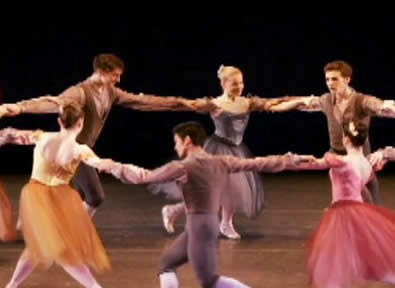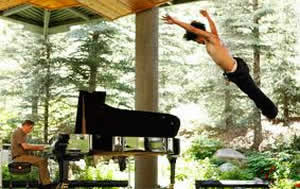 In 2000, philanthropist-turned-filmmaker Anne Bass traveled to Cambodia to on humanitarian voyage. During that trip, she attended a traditional Khmer dance performance in Angkor Wat, where she noticed one of the dancers, Sokvandara-Sy-Sar. Thoroughly impressed by his stage presence and performance, she contacted him after her return to the US and offered him what would be considered a dancer’s dream: the opportunity to travel to the US and audition for New York City’s School of American Ballet, one of the most prestigious dance academies in the world, which is intimately linked to New York City Ballet, the world-famous dance company.
In 2000, philanthropist-turned-filmmaker Anne Bass traveled to Cambodia to on humanitarian voyage. During that trip, she attended a traditional Khmer dance performance in Angkor Wat, where she noticed one of the dancers, Sokvandara-Sy-Sar. Thoroughly impressed by his stage presence and performance, she contacted him after her return to the US and offered him what would be considered a dancer’s dream: the opportunity to travel to the US and audition for New York City’s School of American Ballet, one of the most prestigious dance academies in the world, which is intimately linked to New York City Ballet, the world-famous dance company.
The film portrays Sar’s journey from Cambodia to the US and his transition from Cambodia’s traditional Khmer dance to western classical contemporary ballet. The film shows Sar developing and refining his craft—first as he is being coached by the Russian ballet mistress Olga Kostritzky, then as a student at the School of American Ballet, later as an apprentice, and finally corps de ballet dancer of Seattle’s Pacific Northwest Ballet.
Bass shows us the arduous process Sar puts himself through to learn the art and craft of classical western ballet as well as his impressive accomplishments. At the same time, though, and much to Bass’ credit, she does not shy away from Sar contemplating on-camera whether he really wants to be a ballet dancer and discussing his feelings of displacement: leaving Cambodia when he was just 16, he no longer feels he belongs there, but he has not yet found a home in the US either. The reason for coming to the States and subjecting himself to hard training were simple: he figured he  could make some money with his art to support his family in Cambodia.
could make some money with his art to support his family in Cambodia.
So the film not only offers an insight into the obvious discipline, dedication and hard work it takes to reach perfection as a ballet dancer, but also dips into the more subtle internal struggles of this young man as he questions his profession and choices in life.
It should be noted that Anne Bass’s involvement with Cambodia and its people did not stop with her sponsorship of Sy Sar and making this documentary. Following her first trip, Bass started supporting a number of educational programs. Plus, in collaboration with the Performing Arts Library at Lincoln Center in New York, she founded the KHMER DANCE PROJECT, an initiative with the aim to preserve the traditional Khmer dances of Cambodia by compiling a comprehensive archive and data-base with photos, written documents, videos, audio recordings, and music.
The Khmer Dance Project is considered vital because during the ruling of the radical and brutal Khmer Rouge, between 1975 and 1979, traditional Cambodian Khmer dance was nearly extinct. Under the leadership of Pol Pot, nearly a third of the entire Cambodian population perished, including a large number of Khmer dancers, for dance and the arts were associated with spirituality and royalty—both concepts that were unacceptable to the Khmer Rouge, whose aim was to create a classless, agrarian society.
Only a few of the master teachers survived—many left the country—and the once rich art form was severely depleted of its heritage. The KHMER DANCE PROJECT will ensure that this over-2,000 year-old tradition does not disappear, but will be saved for generations to come.
For more information on DANCING ACROSS BORDERS, please visit www.dancingacrossborders.net.
The DVD of the film is now available from FIRST RUN FEATURES, www.firstrunfeatures.com.

